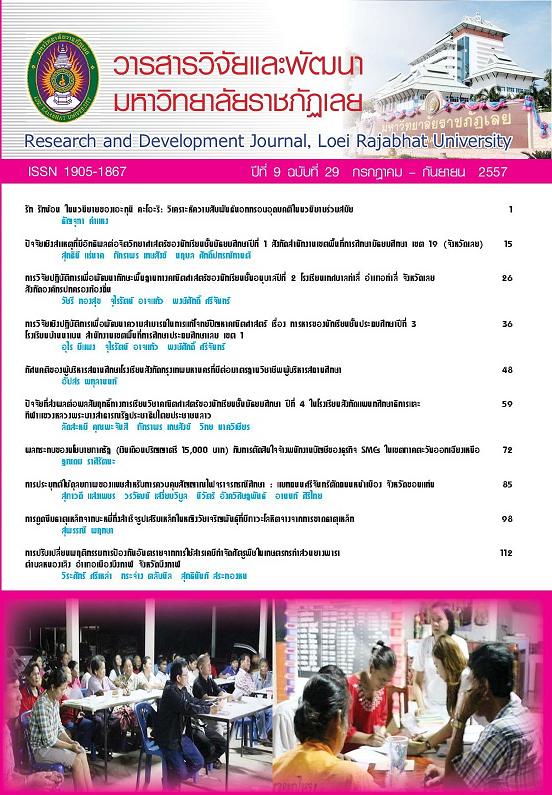การดูดซึมธาตุเหล็กจากบะหมี่กึ่งสำเร็จรูปเสริมเหล็ก ในหญิงวัยเจริญพันธุ์ที่มีภาวะโลหิตจางจากการขาดธาตุเหล็ก
Keywords:
บะหมี่กึ่งสำเร็จรูป, ธาตุเหล็ก, หญิงวัยเจริญพันธุ์, instant noodle, iron, reproduce womanAbstract
บทคัดย่อ
งานวิจัยครั้งนี้เป็นงานวิจัยเชิงทดลอง แบบ cross over design มีวัตถุประสงค์เพื่อศึกษาเปรียบเทียบระดับธาตุเหล็กในซีรั่มภายหลังบริโภคบะหมี่กึ่งสำเร็จรูปที่เสริมและไม่เสริมธาตุเหล็กในหญิงวัยเจริญพันธุ์ที่มีปัญหาภาวะโลหิตจางจากการขาดธาตุเหล็ก ในรูปของ encapsulated iron จำนวน 8 คน โดยให้กับกลุ่มอาสาสมัคร ให้บริโภคบะหมี่กึ่งสำเร็จรูปที่เสริมหรือไม่มีการเสริมธาตุเหล็ก 3.78 มิลลกรัม หรือ 8.93 มิลลิกรัม โดยเว้นระยะห่าง 1 อาทิตย์ในแต่ละการทดสอบ และทำการเก็บตัวอย่างเลือดทุกครึ่งชั่วโมงเป็นเวลา 4 ชั่วโมงภายหลังบริโภคบะหมี่กึ่งสำเร็จรูปที่เสริมหรือไม่มีการเสริมธาตุเหล็ก โดยใช้วิธีเฟอร์โรซีนในการวิเคราะห์ระดับธาตุเหล็กในซีรั่ม และสถิติที่ใช้ในการวิจัย ได้แก่ RM ANOVA และ Paired t-test ผลการวิจัยพบว่าไม่มีการเพิ่มขึ้นของระดับธาตุเหล็กในซีรั่มภายหลังบริโภคบะหมี่กึ่งสำเร็จรูปไม่เสริมหรือเสริมธาตุเหล็ก 3.78 มิลลิกรัม แต่มีการเพิ่มขึ้นของระดับธาตุเหล็กในซีรั่มภายหลังบริโภคบะหมี่กึ่งสำเร็จรูปเสริมธาตุเหล็ก 8.93 มิลลิกรัมเทียบกับระดับเหล็กในซีรั่มพื้นฐานก่อนการบริโภค เมื่อเปรียบเทียบระดับเหล็กในซีรั่มในกลุ่มอาสาสมัครภายหลังการบริโภคบะหมี่กึ่งสำเร็จรูปไม่เสริมหรือเสริมธาตุเหล็ก 8.93 มิลลิกรัมพบว่าไม่มีความแตกต่างกัน และเมื่อเปรียบเทียบปริมาณการเพิ่มขึ้นของธาตุเหล็กในซีรั่มภายหลังการบริโภคบะหมี่กึ่งสำเร็จรูปเสริมธาตุเหล็ก 8.93 มิลลิกรัมพบว่าสูงกว่ากลุ่มอาสาสมัครที่บริโภคบะหมี่กึ่งสำเร็จรูปไม่เสริมอย่างมีนัยสำคัญทางสถิติที่ระดับน้อยกว่า .001 ดังนั้นการบริโภคบะหมี่กึ่งสำเร็จรูปเสริมธาตุเหล็กจึงไม่ใช่แหล่งอาหารธาตุเหล็กที่ควรแนะนำให้บริโภคเป็นประจำทุกวัน หรือแนะนำให้สำหรับผู้มีปัญหาโลหิตจาง เนื่องจากบะหมี่กึ่งสำเร็จรูปมีคุณค่าทางโภชนาการน้อย และยังมีปริมาณโซเดียมที่สูง แต่กรณีที่บริโภคบะหมี่กึ่งสำเร็จรูปควรเลือกบริโภคบะหมี่กึ่งสำเร็จรูปที่มีการเสริมธาตุเหล็กเพื่อให้ได้รับประโยชน์มากขึ้น
Abstract
The objective of this study was to compare serum iron level after ingestion of instant noodle with and without iron fortification in 8 iron-deficient, mildly anemic women. This study was cross over design. Volunteers were randomly selected to ingest either instant noodle with and without iron fortification as encapsulated iron (3.78 mg or 8.93 mg). The volunteers were investigated on two separate weeks with a week apart as a wash-out period between each test. Blood samples were collected every half an hour after the ingestion for 4 hours. FerroZine method was used for serum iron analysis. RM ANOVA and Paired T-Test were used for statistical analysis.
The result showed that there was no increase in serum iron after the ingestion of instant noodle with and without 3.78 mg iron fortification. However, there was an increase in serum iron level after the ingestion of 8.93 mg iron-fortified instant noodle compared to baseline serum iron level. Serum iron level after the ingestion of 8.93 mg iron-fortified instant noodle was not significantly different from that of unfortified instant noodle. Nevertheless, the increase of serum iron after the ingestion of 8.93 mg iron-fortified instant noodle was significantly higher than that of unfortified instant noodle. It should be noted that iron-fortified instant noodle is not recommended for daily intake or for anemic people as it is low in nutrient value and high in sodium. Iron-fortified instant noodle should be chosen to consume during the ingestion of instant noodle ingestion.
Downloads
How to Cite
Issue
Section
License
ข้อความที่ปรากฎในวารสารฉบับนี้เป็นความคิดเห็นของผู้เขียนแต่ละท่าน สถาบันวิจัยและพัฒนา มหาวิทยาลัยราชภัฏเลย และกองบรรณาธิการ ไม่จำเป็นต้องเห็นด้วยและไม่มีส่วนรับผิดชอบใดๆ
สถาบันวิจัยและพัฒนา มหาวิทยาลัยราชภัฏเลย ขอให้ผู้อ่านอ้างอิงในกรณีที่ท่านคัดลอกเนื้อหาบทความในวารสารฉบับนี้






